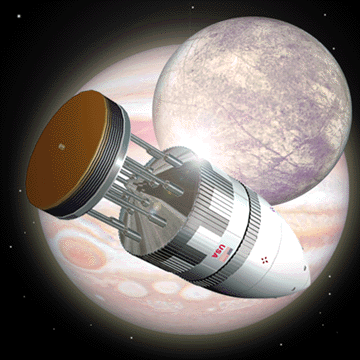
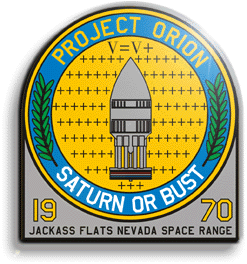
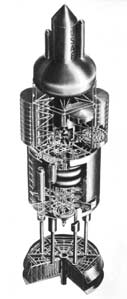
Ofcourse, the real question is, do we launch it? Obviously we can't do that just yet. Laws relating to the ownership of fission and fusion devices are strict to say the very least and the penalties for violating these regulations extremely harsh. Just ask Saddam Hussein, who was only suspected of aquiring such technology. Peaceful intentions or no we aren't going to get our hands on either enriched Uranium or Plutonium very easily, so an immediate launch is rather unlikely. The good news is that this saves us a lot of money.
Specially designed pulse units(nuclear bombs) are by far the most complex items necessary for a completed Orion. Many hundreds if not thousands of them would be needed for an interplanetary mission. By drawing a line through all the expenses involved with their development and purchase, not only do we deftly avoid the political obstacles facing us, we reduce the overall costings by atleast half. No need to hire a nuclear weapons manufacturer for a new line of specialised thermonuclear bombs with all the red tape that would entail. Matters are simplified enormously. The ship itself is purely straightforward hands on engineering.
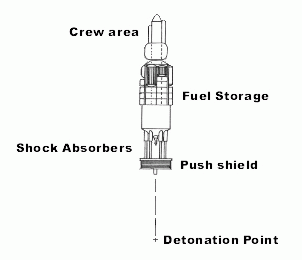
Without nuclear pulse units an Orion is just a big building. Therefore we don't violate any of those antiquated nuclear proliferation treaties by constructing one. An engineering challenge most certainly. But no more impossible than building a cruise ship. So who do we hire to build it? Back in the 1960's the proposed contractor was Electric Boat of General Dynamics, the major submarine contractor for the US Navy. Electric Boat built the first nuclear submarine and the first ballistic-missile submarine. Orion could be built of steel without any special fittings and floated from the company's shipyard in Groton, Connecticut or it's hull-fabrication and outfitting facility in Quonset Point, Rhode Island. In fact, any major shipyard with adequate facilities to construct large ocean going vessels should be able to handle it.
When it comes to scale and design we are blessed with an enormous range of sizes to choose from. Many dimensional configurations were tossed around back in the late 1950's and early 1960's. Here are some more. The thing about Orions which bears remembering and I've said before is that the larger you build them the more efficiently they operate. The complete opposite to conventional chemical rockets which suffer increasingly nightmarish difficulties and lower per kilo efficiency as you scale them up. For instance, the shielding gets more difficult as you scale your Orion down. The effectiveness of shielding depends on the thickness. About 60cm of shielding is ideal but 30cm is insufficient. In a large Orion the plate, structure, stored pulse units and so on provide enough shielding on their own to protect the crew. With small vehicles extra shielding must be added and that reduces your available payload. There is also the matter of atomic bomb design. If we want to build our vehicle with a view to possibly launching it one day then larger bombs make a lot of sense. It's wasteful and difficult to make small nukes. The less fissionable material the more difficult it is to compress and keep from fizzling out. You get a dirtier bomb too. With larger devices you can use enriched Uranium instead of Plutonium. We might not be building any pulse units but they are an essential component and if we want a functional vehicle we must scale it up to the most practical type of pulse unit. On the offchance that our Orion does actually some day fly it therefore makes sense to build it really big. For a 4000 ton Orion Mark 2 vehicle the pusher plate alone weighs 1000 tons and measures no less than 40 metres in diameter. A more useful size would be around 10,000 tons. Even 100,000 tons. The bigger we build it the simpler the design and the greater the chances of it successfully taking off some day. While revolutionary the actual concept is surprisingly simple and that means fewer possible flaws. It also means we can add more safety features. State of the art back up systems for the back up systems and then some. We don't want to create fresh problems by constructing a small innefficient vehicle which requires complex new systems just to make it workable. Big and simple is better than small and complex. We want a solid and sturdy overall structure designed to 10 g's standard. Early rocket planes had such specifications and at launch an Orion might fire up to five pulses per second.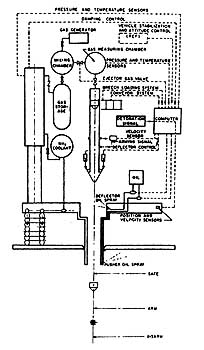
Bomb ejector system. Inspired by a coke machine!
So what do we do with it when it's finished if we can't fly to mars? The most obvious answer is to open it up to the public as the world's only existing starship. Except for not being fueled up, this will be a complete and ready to launch Orion. A Starship in the true sense of the word. It might take generations to ever reach Alpha Centaurii but it could make such a fantastic journey. Nothing else comes close to a fraction of it's engine power. Therefore it can be classed as a Starship and that sounds more impressive anyway.
© Copyright 2002, Matthew Poliakon.
It would be no exaggeration to state that this would be the greatest man made wonder in the world. The lounges would be furnished, the control room wired up with state of the art computers, air locks pressurised, spacesuits hanging in wardrobes and shuttles firmly attached to the docking bays. Not a scale model but a full sized authentic spaceship potentially capable of carrying hundreds of people to the furthest reaches of the solar system and beyond. This bullet shaped mountain of metal would require maintenance, so guided tours through it's maze of rooms and coridoors would have to incur a fee. An entire space theme amusement park could eventually grow around the construction site. Every Star Trek fan and science buff in the world would want to visit it.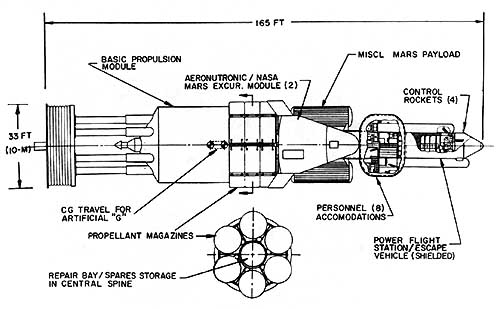
I believe it would eventually be allowed to fly. It's existance would alert every human on earth to the possibility that it could actually fly. Debates would be inevitable. Public awareness of the issues involved would grow and an informed public would question the flawed arguments preventing such a mission.It would be a crime not to launch such a beautiful creation. The huge financial and technological benefits of such an adventure would fire up the public's imagination. People would watch NASA's feeble attempts at space travel in a whole new light. It would only be a matter of time in my opinion.
Ofcourse, if that fails we can always hope for a large asteroid to swing this way. A long shot I know, but the possibility of a major impact from space is a dead certainty. The geological record shows the Earth has been hit many times by large objects. Some of them coming very close to sterilising this rock overnight. In the event of true Armageddon the governments of this world would be tripping over themselves to fabricate pulse units and send Orion on it's maiden voyage.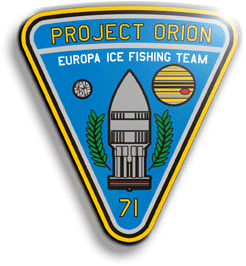
© Copyright 2002, Matthew Poliakon.
Asteroids are one of the very few threats to us that we currently have no prepared defense against whatsoever. So having the ultimate rocket on standby isn't a bad idea. Our 10,000 ton(or bigger) Orion could successfully deflect such a wayward astronomical body. There is nothing else we can build which would either reach such a threat in time or indeed make any impact on it.
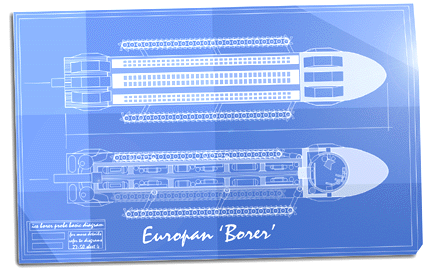
© Copyright 2002, Matthew Poliakon.
And if we do get permission to launch our Orion then we can probably find a way to build this reactor powered ice mole. Ideal for tunneling through the surface of Europa, an icy moon of Jupiter believed to harbour an enormous ocean below it's crust. What will we find there? Nobody knows.
ProjectOrion.com intro page.
Why launch an Orion?
Fallout Fallacies.
Orion Links.
Space Message Board.
Project Orion Funding Update!
Project Orion Gallery.
Many original images/graphic work © Copyright 2002, Matthew Poliakon.
Please visit http://Sputnik1.com for more details about this artist and his work.